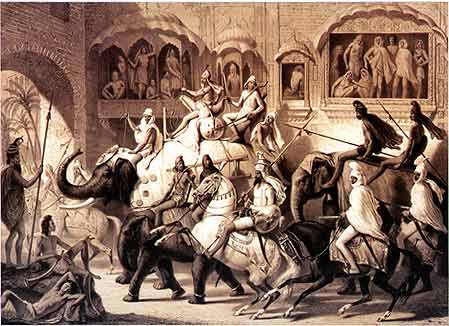


A street scene of Lahore (painted by the Russian Painter Soltykoff)
"Androon Shehar" (the Walled City) or the Old Lahore north-west of Lahore contains the heart of Lahore - its original cultural property in the form of mosques, forts, gateways, residential buildings, palaces, tombs, alleyways and open squares. These when coupled with the traditional cultural activities and social relationships, enhance the character of the Walled City with its individual buildings and bazaars. Old Lahore is the dense, tottering, bazaar-city of Kipling's stories, and some of his titles, like The Gate of a Hundred Sorrows, could serve as name plaques every few steps. Old Lahore is anarchic, boisterous, crammed, decrepit, exuberant, and aromatic, though, it lost much of its grandeur when most of it was burnt down during the partition of British India.
The true "Lahori" life is visible everywhere when one walks through its narrow winding alleys. In early morning, the traditional breakfast of "Halwa and Poori" (below second from left) is seen being made by the corner of the street. One really enjoys the paper thin "Poori" - made of flour and fried in boiling hot oil with a "Bhaaji" - a dish made of grams and potatoes with pickle and onions, followed by "Halwa" - a sweet made of sooji, sugar and ghee. After this rather heavy feast, Lahories never forget to drink a large glass of "Lassi" (below third from left) - made from yogurt, sugar and water in one gulp. Try this whenever you are in Lahore.
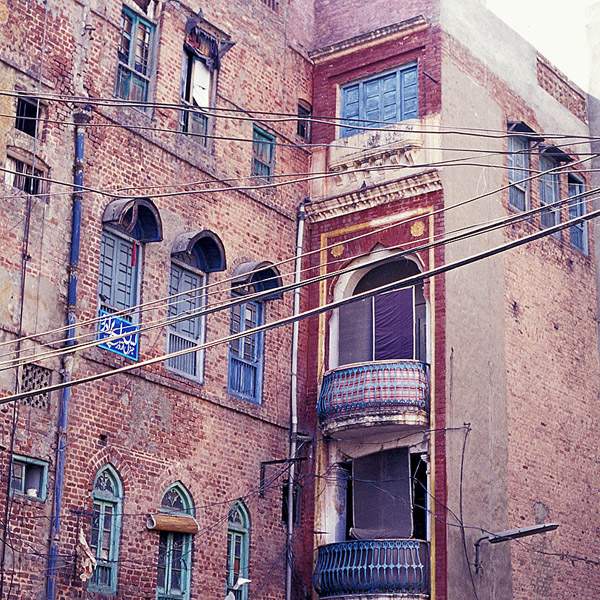
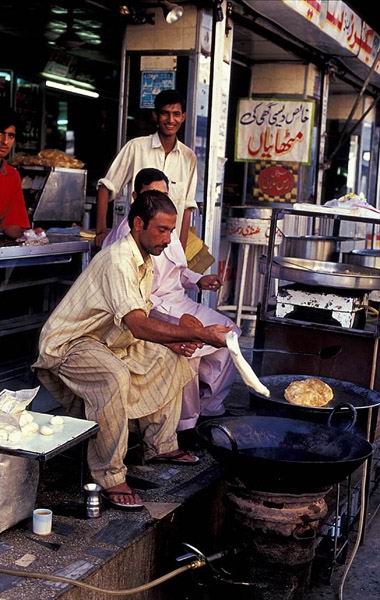
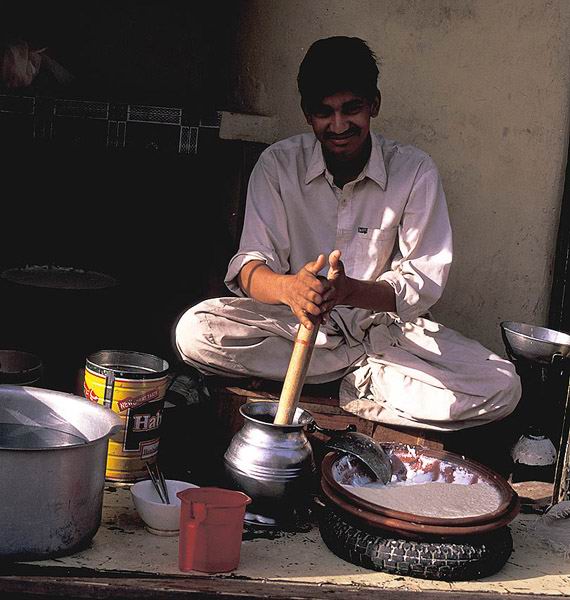
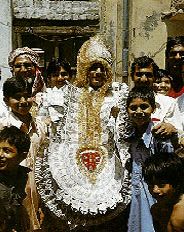
Life in the Walled City is more fun and lively. The marriages are a scene to be seen. The groom wearing garlands (above right) made from currency notes of lower denominations walks or horse rides to the would be bride's house, accompanied by his friends dancing all the way on the beat of drum or "dhol". During the spring season, the festival of kite flying or Basant attracts rich and poor from all parts of Lahore to the walled city. For days the festivities continue, but on actual Basant day, all roof tops of havelies and other high rising houses are jam packed with kite flyers and onlookers.
The Faqir Khana Museum is a private family collection housed in an ancient haveli in Old Lahore. A founding member of the family served as a prime minister and royal physician in the court of Emperor Ranjit Singh. Many of his gifts to the family are featured in the museum. Treasures include royal robes worn by 18th century Mughal kings, a portrait of Queen Victoria, framed in gold and set in real turquoise, presented to Maharaja Singh by Lord Auckland, and a stone poison filter tested by a drug company, proven to work.
Gates of Walled City: An other historical heritage of the Walled City was its wall and the 13 gates leading into the city. Over a period of time the wall has withered away along with some of the gates. The 13 gates are generally known in the name of places they are facing or any important building in their vicinity. These gates are believed to be constructed during Emperor Akbar's rein (1584 -1598). During Ranjit Singh's times, the fast falling walls were rebuilt in 1812. During the British era, the height of the walls was reduced from 30 to 15 feet. However, these walls gradually vanished, leaving their gates as the only reminiscent and glory of the past. See a 1912 Map of Lahore city.
|
Dehli Gate
It is so-called from its opening on to the high road from Lahore to Dehli. As part of the reconstruction of selected sites of Walled City, this gate has also been renovated. Many a historical places such as Shahi Hamam (Royal Bath), Chitta Darvaza (White Door), a number of old havalies and the famous Masjid Wazir Khan are situated inside this gate. More Pictures
|
Taxali Gate
The Taxali gate takes its name from "Taxal" or Mint located nearby. It once provided access through the wall that extended the western length of the city. It was heavily fortified and was designed to protect the city from any attack from the west-ward." With the passage of time this gate has completely vanished.
|
Bhaati Gate
"Bhatties" - one of the leading sub-caste of Rajputs once abounded the area of walled city, where this gate was constructed. Therefore the gate derived its name accordingly. This gate is situated at the south-western bend of the city in its renovated form. For some unknown reasons, whenever referring to the Lahorites, mention of this gate is the first one that comes to the mind.
|
Lahori Gate Undoubtedly, the gate derives its name from the city of Lahore. Since the gate faces present Ichra, which was the actual Lahore in Hindu Raj, it is known as Lahori Gate. This gateway still exists in its renovated form and is famous for being one of the main entrances of the city. The out way from the famous Anasrkali bazar leads directly to this gate. The gate is locally referred to as "Lohari" instead of "Lahori". |
|
Shah Aalmi Gate
This gate is named after Mohamad Moazam Shah Alam Bahader Shah, the son and successor of Aurangzaib. During the partition riots in 1947, this gate was burnt to ashes, now only the name remains.
|
Mochi Gate This gate was situated between Shah Aalmi and Akbari Gate. Mochi Gate has been named in honour of Moti, a Hindu guard of the gate during the Mughal era, who guarded and looked after the gate all his life. Later the name was distorted and became Mochi. There is a prominent grave of a saint, which in olden times, this grave was in one of the cubical of the gate. |
Akbari Gate
This gate was named after the Emperor Akbar who rebuilt the town and the citadel. No traces of it exist today. However, the nearby famous market place "Akbari Mandi" takes its name from Emperor Akbar.
Sheran Wala Gate During the reign of Ranjit Singh he had kept here two domesticated lions (Sher in urdu) and the gate came to be called Sheran Wala Gate. |
Yakki Gate The original name was 'Zaki' - after the name of a saint who according to tradition died fighting against the Mughals, while gallantly defending the city. It is said that even after his head was cut off at the gate, his trunk continued fighting for sometime, and then fell close by. Head and the trunk of the saint was buried at their fallen places separately and both are revered to this day. No traces of this gate are found now. |
|
Kashmiri Gate
Since the gate faces the direction of Kashmir, it is called Kashmiri Gate. The gate has also been renovated and exists till date. |
Raushnai Gate The most prominent gate, situated at the northern extreme of the city, adjacent to the Lahore Fort. Since it was generally lit at night, it got its name from the urdu word "Raushni" (the light). Being the principal entrance form fort to city, it was most frequented by the high gentry, courtiers and royal servants. Due to its dilapidated condition, the gate is permanently closed. (photo courtesy: Autumn Sun and Autumn Colours ) |
Masti Gate The name is a corruption of 'Masjadi Gate' referring to the mosque of Mariam Makani, mother of Emperor Akbar, situated in its immediate vicinity. A little trace of this gate in its renovated form can still be seen. Mori Gate Although never a gate like the rest of the 12 gates, the so-called 13th gate, named as Mori Gate, was in old time a place used as outlet for the refuse and the sweepings of the city. |
|
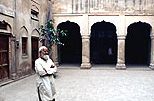 Today, however, the Walled City's infrastructure is seriously threatened physical decay and the demolition and rebuilding in the Walled City are constantly diminishing its historic fabric. In order to preserve its historical and cultural associations, the Government of Pakistan and the World Bank in 1983 prepared a cultural heritage conservation plan through the World Bank's Lahore Urban Development Project, which focused on the repair and restoration of the Delhi Gate (a principal entrance to the Walled City), the Delhi Gate Bazaar and the Shaahi Hammam
(Royal Baths), located just inside the Delhi Gate. To address the infrastructure and economic problems of the Walled City, the project financed the upgrading of the water supply, sewerage, drainage, paths and roadways, solid waste collection, electricity and traffic management.
Today, however, the Walled City's infrastructure is seriously threatened physical decay and the demolition and rebuilding in the Walled City are constantly diminishing its historic fabric. In order to preserve its historical and cultural associations, the Government of Pakistan and the World Bank in 1983 prepared a cultural heritage conservation plan through the World Bank's Lahore Urban Development Project, which focused on the repair and restoration of the Delhi Gate (a principal entrance to the Walled City), the Delhi Gate Bazaar and the Shaahi Hammam
(Royal Baths), located just inside the Delhi Gate. To address the infrastructure and economic problems of the Walled City, the project financed the upgrading of the water supply, sewerage, drainage, paths and roadways, solid waste collection, electricity and traffic management.
The completion of the conservation projects restored several highly visible structures that are of great symbolic importance to the old Walled City. These buildings are now used for socially valuable activities and have the potential to stimulate private upgrading in the surrounding area.
Related Links: | Lahore as Kipling Knew It | Conservation of the Urban Fabric Walled City of Lahore |
|
| HOME PAGE | LAHORE | MORE CITIES |
This page was created on 1 January 2005
/ |